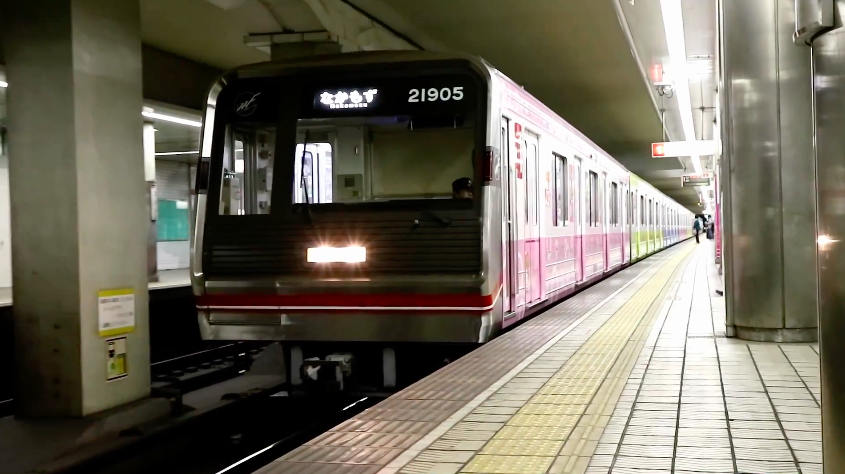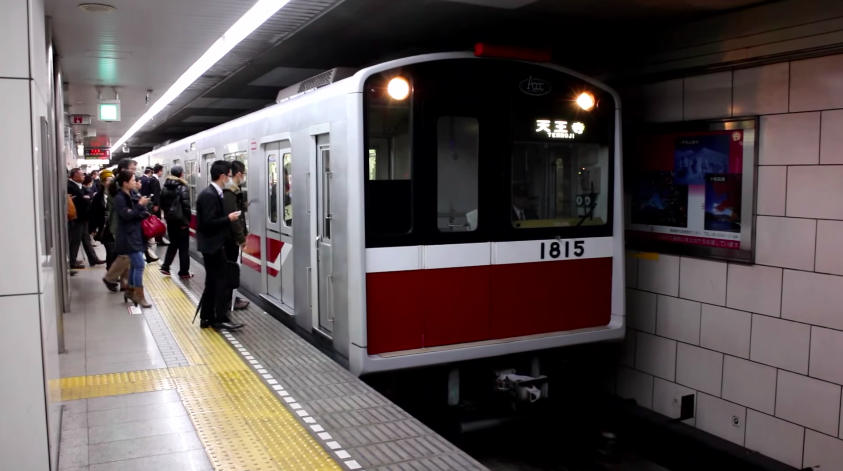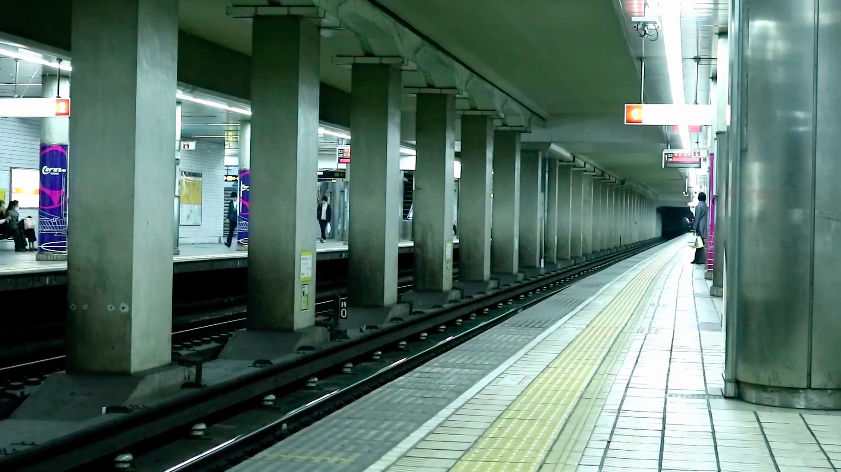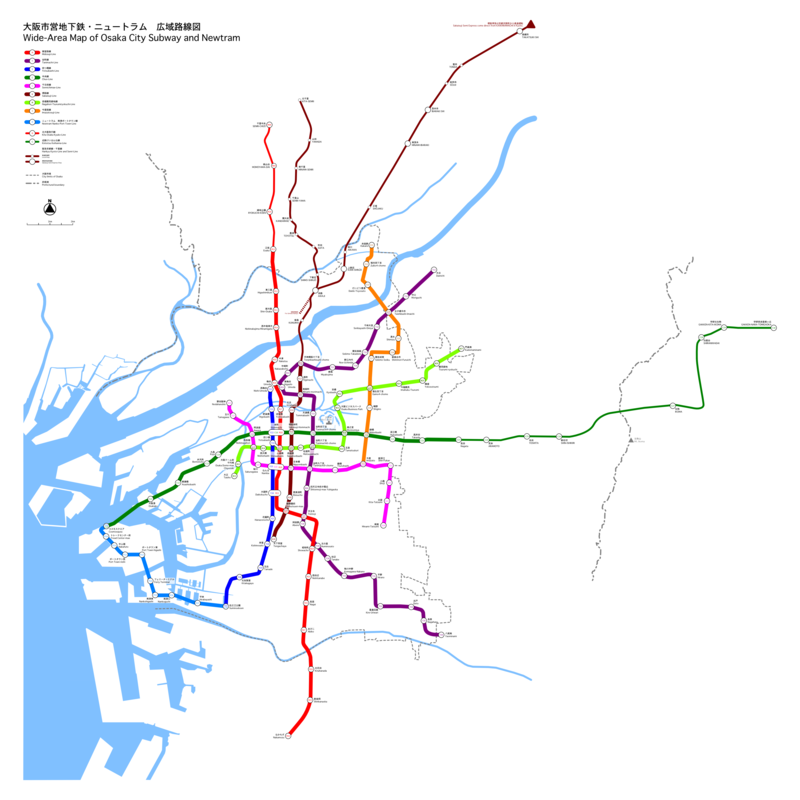Osaka Municipal Subway is an indispensable organ of Greater Osaka public transport system and is the primary mode of mass transport in the Kansai region, Japan. This electrified metro system serves Osaka and nearby cities of Kadoma, Higashiosaka, Sakai, Moriguchi, Yao and Suita in Kansai region. Currently, it consists of 8 lines and a people mover, connecting total 133 stations along a 137.8 km long track.
Osaka Municipal Subway
Introduction
Every day, around 2.29 million commuters travel through this subway system. In terms of annual ridership, it is 8th in the world. One of the big advantages of the metro system is that it allows easy commute to the Kansai International Airport.
Osaka Municipal Transportation Bureau is operating the lines. Osaka metro uses either third rail system or overhead catenary for electrification. Despite having all of the features of a full-service metro railway, this subway system is actually registered as a tramway.
Historical Background
Osaka is the main city of Japan’s second largest metropolitan area Keihanshin. With a huge population and consequently high volume of commercial activity, this city and surrounding areas constitute a major hub of Japan.
Easy to understand in such a big region, managing traffic was always a concern for the local government. Again, the construction was necessary to provide a means of employment to the unemployed workforce of the city. In1933, between Umeda and Shinsaibashi stations, the first line of Osaka Municipal Subway, Midōsuji Line was started operation.
Construction of the further lines was stopped due to the World War II and began again after ceasing of war. Midōsuji Line achieved its current length in 1987. It is, at this moment, the second longest metro line in the city of Osaka.
The Yotsubashi Line started operation in 1942 between Daikokuchō and Hanazonochō. It achieved its current length in 1972. In 1961 an elevated portion of Chūō Line between Ōsakakō and Bentenchō was opened. After many extensions, the current track length was achieved in 1985.
Tanimachi Line is operational since 1967. Initially, revenue service began between Higashi-Umeda and Tanimachi Yonchōme. In 1983, the last extension took place from Moriguchi to Dainichi.

In 1969, another two lines, namely, Sennichimae Line and Sakaisuji Line entered revenue service. In 1981, Sennichimae Line achieved its current length from Nodahanshin to Minami-Tatsumi. The track for Sakaisuji Line, from Tenjimbashisuji Rokuchōme to Tengachaya was fully opened in 1993. Nagahori Tsurumi-ryokuchi Line, between Kyōbashi and Tsurumi-ryokuchi was opened in 1990. In 1997, it was further extended to both sides. The last line, Imazatosuji Line started full service in 2006, connecting Itakano to Imazato. In 1981, the people mover line, namely, Nankō Port Town Line was opened between Nakafuto and Suminoekōen. The last extension in this line took place in 1997 from Nakafuto to Cosmosquare.
Hours of Operation
Trains of Osaka Municipal Subway run from 5 AM to 12 AM. Trains are available every day of the week. However, on weekends and holidays, only fewer trains run. On rush hours, one train comes every 3-4 minutes, rest of the day, every 7-8 minutes. Train frequency may vary depending upon the particular line.
View the timetable of first and last trains on different lines here.
Lines and Stations
The current system includes 8 lines differentiated by color, symbol and name. The station names are created using the first letter of the line name and the station number. The total track length of these 8 lines is 129.9 km covering 123 stations. In addition, the system also includes an automated people mover which covers another 10 stations.
Line 1 (Midōsuji Line)
This is the first metro line of Osaka Municipal Subway and the second metro line in Japan. It is again the busiest line in the whole system. Midōsuji Line is also called Osaka City Rapid Railway Line No. 1 and Rapid Electric Tramway Line No. 1. On the map, this line appears red and is marked with the letter M. The line is constructed just under the north-south main street Midōsuji and hence the name.
The track is 24.5 km along 20 stations. Some of the stations are elevated; some are underground. At present, 10 car trains run on this line.
From this line, one can transfer to other railway systems e.g. Kita-Osaka Kyuko Railway and Hankyu Railway and also to other lines e.g. Sennichimae Line and Tanimachi Line of Osaka Subway system. A complete travel on this line takes around 40 minutes time.
Main stations on this line are: Nakamozu, Nagai, Tennōji, Dōbutsuen-mae, Daikokuchō, Namba, Shinsaibashi, Hommachi, Yodoyabashi, Umeda, Nishinakajima- Minamigata, Shin-Ōsaka’, Esaka
Line 2 (Tanimachi Line)
It is again a north-south line running parallel to Line 1. It is also called Osaka City Rapid Railway Line No. 2 and Rapid Electric Tramway Line No. 2. On the subway map, it appears royal purple in color and is marked with Letter T.
The line is 28.1 km long and covers 26 stations. It runs through Tanimachi-suji where most of the Buddhist temples and important government buildings are located. Most of the line is underground with a small portion near Yaominami Station being elevated. Currently, 6 car trains run on this line.
This line offers interchange to other Osaka Subway lines and also to Hankyu Senri Line, Hankai Uemachi Line etc. It takes around 50 minutes to complete a travel along this line.
Main stations on this line are: Yaominami, Abeno, Tennōji, Tanimachi Kyūchōme, Tanimachi Rokuchome, Tanimachi Yonchōme, Temmabashi, Higashi-Umeda, Tenjimbashisuji, Rokuchōme, Taishibashi-Imaichi, Dainichi
Line 3 (Yotsubashi Line)
Known as Osaka City Rapid Railway Line No. 3 or Rapid Electric Tramway Line No. 3, this line also runs parallel to Line 1 but has a track length of only 11.4 km. There are 11 stations on this line. All of the stations are underground. Each train on this line consists of 6 cars.
On the subway map, you can identify the line by its dark blue color and by the letter Y attached to it. From this line, one can transfer to Nankai Railway, Hanshin Railway and JR West and of course, to other lines of Osaka Subway system. It takes 20 minutes to travel on the complete track.
Main stations on this line are: Suminoekōen, Daikokuchō, Namba, Yotsubashi, Hommachi, Higobashi, Nishi-Umeda

Line 4 (Chūō Line)
This is an east-west line running underground, following the route of Chūō Avenue. It is also known as Osaka City Rapid Railway Line No. 4 and Rapid Electric Tramway Line No. 4. On the subway map, it is indicated by green color and marked with the letter C.
The line has total 17.9 km of length, including 14 stations. After leaving the Awaza Station up to Ōsakakō Station, the stations are elevated. The rest of the stations are underground. Currently 6 car trains run on this line.
This is the only line that offers you transfer to all other lines under Osaka Municipal Transportation Bureau. A complete travel on this line takes around 30 minutes.
Main stations on this line are: Nagata, Midoribashi, Tanimachi Yonchōme, Hommachi, Bentenchō, Cosmosquare
Line 5 (Sennichimae Line)
The line runs from the northwestern side of the city to the southwestern part through the business and recreational hub Namba. It is also called Osaka City Rapid Railway Line No. 5 and Rapid Electric Tramway Line No. 5. The line is indicated on the map by pink color and also by the letter S.
It has a 12.6 km long track through 14 stations. All the stations on this line have platform screen doors. It takes around 27 minutes to complete a travel along the line. Interchanges to other Osaka Subway lines and also to other railway systems of the city are possible from this line.
Main Stations on this line are: Minami-Tatsumi, Imazato, Nippombashi, Namba, Awaza, Nodahanshin
Line 6 (Sakaisuji Line)
Also known as Osaka City Rapid Railway Line No. 6 or Rapid Electric Tramway Line No. 6, this line connects Tenjimbashisuji Rokuchōme to Tengachaya. It is shown as a brown colored line on the map, indicated by the letter K.
The length of the track is only 8.1 km but there are 10 stations on the line. Transfer option is almost similar with other Osaka Subway lines. A complete travel on this line takes around 17 minutes.
Important stations on this line are: Tengachaya, Dobutsuen-mae, Sakaisuji-Hommachi, Ōgimachi, Tenjimbashisuji Rokuchōme
Line 7 (Nagahori Tsurumi-ryokuchi Line)
This line offers convenient transport to the events of Osaka Dome. It is also called Osaka City Rapid Railway Line No. 7 and Rapid Electric Tramway Line No. 7. It is the first linear motor metro line in Japan. On subway map, it appears with Green color and is marked with the letter N.
The length of the line is 15.0 km which is distributed among 17 stations. All the stations are underground. It allows transfer to other Subway lines and also to Osaka Loop Line and to Hanshin: Namba Line. To complete a travel on this line, you’ll need around 32 minutes.
Main stations on this line are: Kadoma-minami, Gamō-yonchōme, Kyōbashi, Morinomiya, Nagahoribashi, Nishi-Nagahori, Taishō
Line 8 (Imazatosuji Line)
It is a north-south line running in the eastern part of the city. It travels under multiple national routes and intersects other railway lines. Known as Osaka City Rapid Railway Line No. 8 or Rapid Electric Tramway Line No. 8, this line is 11.9 km long. There are 11 stations on this line. On the Subway map, it appears golden in color and is marked with the letter I.
Transfer possibilities from this line are much limited compared to other Osaka Municipal Sunway lines. To travel on the complete route, you need 23 minutes.
Main stations on this line are: Imazato, Gamō Yonchōme, Sekime-Seiiku, Taishibashi-Imaichi, Itakano
Nankō Port Town Line
Also known as New Tram, this line is an automated people mover serving the Suminoe-ku province of Osaka city. It is a 7.9 km long line having 10 stations along it. On the map, it will appear light blue in color and is marked with the letter P. From this line transfer is possible to Chūō Line and Yotsubashi Line.
Main stations on this line are: Suminoekōen, Nankōguchi, Ferry Terminal , Port Town-nishi, Trade Center-mae, Cosmosquare
Future expansions
There are plans to extend 4 lines, namely, Sennichimae Line, Yotsubashi Line, Imazatosuji Line and Nagahori Tsurumi-ryokuchi Line further. In addition, a new line is going to be constructed between Suminoekōen and Kire-Uriwari. However, in view of the cost of construction, the government may choose to privatize the system or make it a light rail or bus service.

Fare and Ticket
The fare in Osaka Municipal Subway system is determined on the basis of travel distance. Distances are represented by 5 different zones. An adult’s fare for single journey ranges between 180 Yen to 370 Yen. For children, the fare is almost half of the adult’s fare. Babies and two infants (1-5 years old) can ride with an adult guardian for free. For children between 6 to 11 years, child fare should be paid.
People with disability or rehabilitation certificate get 50% discount on the ticket fares. Besides the common single journey ticket, multiple types of tickets or cards are available that facilitate travel for locals and visitors. Some of such cards are Multiple Ride card, Enjoy Eco card, Osaka Visitors Ticket etc.
Get the details on fare and ticket from here.
Facilities and Services
To make your journey with Osaka Municipal Subway memorable, the Transportation Bureau offers the following services:
- All written instructions and important announcements are in Japanese as well as in English.
- Most of the subway stations have their own free parking lots for bikes and four wheelers. Paid parking areas are also there in the nearby.
- Station toilets on some lines are also suitable for ostomy pouching systems.
Rules
All passengers must abide the metro use rules set by the Osaka Municipal Transportation Bureau to ensure smooth functioning of the system.
- Except guide dogs of visually impaired riders, no pet is allowed on the trains.
- Before you leave a station, you must return your ticket purchased to enter it.
- Able-bodied persons should never occupy the priority seats.
Tips
Following tips may come handy while traveling through Osaka Subway:
- In case you have paid more or less than the exact fare amount, you can correct it at the norikoshi machines located at the stations.
- If you are not sure about the fare, transfer or any other travel related matters, don’t hesitate to contact the service manager present on the station.
Media
Metro map of Osaka
Map via www.kotsu.city.osaka.lg.jpSee map full resolution. It may take a little bit to load.
Download map.
Osaka Subway map
- Also Known As: Subway
- Passengers/Day 2360000
- Fares: gates, smartcard
- 24h operation: No
- Air Conditioning: No
- Walk between platforms: Yes
- Driverless trains: Nanko Port Town Line, rubber-tyred (since 1981)
- Screen Doors Platforms: All stations on the Nanko Port Town Line
- Operator: Osaka Municipal Transportation Bureau
- 850 yen
- Osaka Metro Official Website
Help us
If you consider that the information we provide is wrong, not accurated, outdated, translation contains errors, and you would like to help us to improve the file...you can contact us here.
Feel free to contact us if you dont find the system you're looking for and we'll add it as soon as we can!
Thank you very much!







